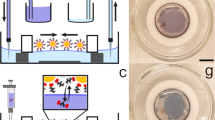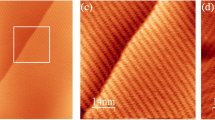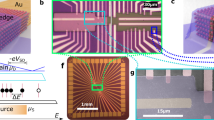Abstract
The realization of molecule-based miniature devices with advanced functions requires the development of new and efficient approaches for combining molecular building blocks into desired functional structures, ideally with these structures supported on suitable substrates1,2,3,4. Supramolecular aggregation occurs spontaneously and can lead to controlled structures if selective and directional non-covalent interactions are exploited. But such selective supramolecular assembly has yielded almost exclusively crystals or dissolved structures5; the self-assembly of absorbed molecules into larger structures6,7,8, in contrast, has not yet been directed by controlling selective intermolecular interactions. Here we report the formation of surface-supported supramolecular structures whose size and aggregation pattern are rationally controlled by tuning the non-covalent interactions between individual absorbed molecules. Using low-temperature scanning tunnelling microscopy, we show that substituted porphyrin molecules adsorbed on a gold surface form monomers, trimers, tetramers or extended wire-like structures. We find that each structure corresponds in a predictable fashion to the geometric and chemical nature of the porphyrin substituents that mediate the interactions between individual adsorbed molecules. Our findings suggest that careful placement of functional groups that are able to participate in directed non-covalent interactions will allow the rational design and construction of a wide range of supramolecular architectures absorbed to surfaces.
This is a preview of subscription content, access via your institution
Access options
Subscribe to this journal
Receive 51 print issues and online access
$199.00 per year
only $3.90 per issue
Buy this article
- Purchase on Springer Link
- Instant access to full article PDF
Prices may be subject to local taxes which are calculated during checkout




Similar content being viewed by others
References
Wada, Y. et al. Prospects and problems of single molecule information devices. Jpn J. Appl. Phys. 39, 3825–3846 (2000).
Collier, C. P. et al. Electronically configurable molecular-based logic gates. Science 285, 391–394 (1999).
Lopinski, G. P., Wayner, D. D. M. & Wolkow, R. A. Self-directed growth of molecular nanostructures on silicon. Nature 406, 48–51 (2000).
Joachim, C., Gimzewski, J. K. & Aviram, A. Electronics used hybrid-molecular and mono-molecular devices. Nature 408, 541–548 (2000).
Lehn, J.-M. Supramolecular Chemistry: Concept and Perspectives (VCH, Weinheim, 1995).
Furukawa, M., Tanaka, H., Sugiura, K., Sakaya, Y. & Kawai, T. Fabrication of molecular alignment at the specific sites on Cu(111) surface using elf-assembly phenomena. Surf. Sci. Lett. 445, L58–L63 (2000).
Barth, J. V. et al. Building supramolecular nanostructures at surfaces by hydrogen bonding. Angew. Chem. Int. Edn Engl. 39, 1230–1234 (2000).
Bohringer, M. et al. Two-dimensional self-assembly of supramolecular clusters and chains. Phys. Rev. Lett. 83, 324–327 (1999).
Sugiura, K. et al. X-ray photoelectron spectroscopy of metallo porphyrins having bulky substituents: Standard values of core ionization potentials. Chem. Lett. 841–842 (1999).
Jung, T. A., Schlittler, R. R., Gimzewski, J. K., Tang, H. & Joachim, C. Controlled room-temperature positioning of individual molecules: Molecular flexure and motion. Science 271, 181–184 (1996).
Jung, T. A., Schlittler, R. R. & Gimzewski, J. K. Conformational identification of individual adsorbed molecules with the STM. Nature 386, 696–698 (1997).
Moresco, F. et al. Conformational changes of single molecules induced by scanning tunneling microscopy manipulation: A route to molecular switching. Phys. Rev. Lett. 86, 672–675 (2001).
Moresco, F. et al. Low temperature manipulation of big molecules in constant height mode. Appl. Phys. Lett. 78, 306–308 (2001).
Yokoyama, T. & Takayanagi, K. Size quantization of surface-state electrons on the Si(001) surface. Phys. Rev. B 59, 12232–12236 (1999).
Barth, J. V., Brune, H., Ertl, G. & Behm, R. J. Scanning tunneling microscopy observations on the reconstructed Au(111) surface: Atomic structure, log-range superstructure, rotational domains, and surface defects. Phys. Rev. B 42, 9307–9318 (1990).
Chambliss, D. D., Wilson, R. J. & Chiang, S. Nucleation of ordered Ni island arrays on Au(111) by surface-lattice dislocations. Phys. Rev. Lett. 66, 1721–1724 (1991).
Yokoyama, T., Yokoyama, S., Kamikado, T. & Mashiko, S. Nonplanar adsorption and orientational ordering of porphyrin molecules on Au(111). J. Chem. Phys. 115, 3814–3818 (2001).
de Rege, P. J. F., Williams, S. A. & Therien, M. J. Direct evaluation of electronic coupling mediated by hydrogen bonds: implications for biological electron transfer. Science 269, 1409–1413 (1995).
Find, H.-W. & Schonenberger, C. Electrical conduction through DNA molecules. Nature 398, 407–410 (1999).
Cai, L., Tabata, H. & Kawai, T. Self-assembled DNA network and their electrical conductivity. Appl. Phys. Lett. 77, 3105–3106 (2000).
Acknowledgements
T.Y. would like to thank K. Kimura, Y. Takaguchi and Y. Wakayana for useful discussions.
Author information
Authors and Affiliations
Corresponding author
Rights and permissions
About this article
Cite this article
Yokoyama, T., Yokoyama, S., Kamikado, T. et al. Selective assembly on a surface of supramolecular aggregates with controlled size and shape. Nature 413, 619–621 (2001). https://doi.org/10.1038/35098059
Received:
Accepted:
Issue Date:
DOI: https://doi.org/10.1038/35098059
This article is cited by
-
A semi-automated material exploration scheme to predict the solubilities of tetraphenylporphyrin derivatives
Communications Chemistry (2022)
-
Initiating Ullmann-like coupling of Br2Py by a semimetal surface
Scientific Reports (2021)
-
Polycyclic aromatic chains on metals and insulating layers by repetitive [3+2] cycloadditions
Nature Communications (2020)
-
Nonlinear optical properties and spectroscopic characterization of Y-shaped polymer using quantum chemical approach
Journal of Molecular Modeling (2020)
-
Harmonic velocity noise and its resonance in classical systems
Indian Journal of Physics (2019)
Comments
By submitting a comment you agree to abide by our Terms and Community Guidelines. If you find something abusive or that does not comply with our terms or guidelines please flag it as inappropriate.



